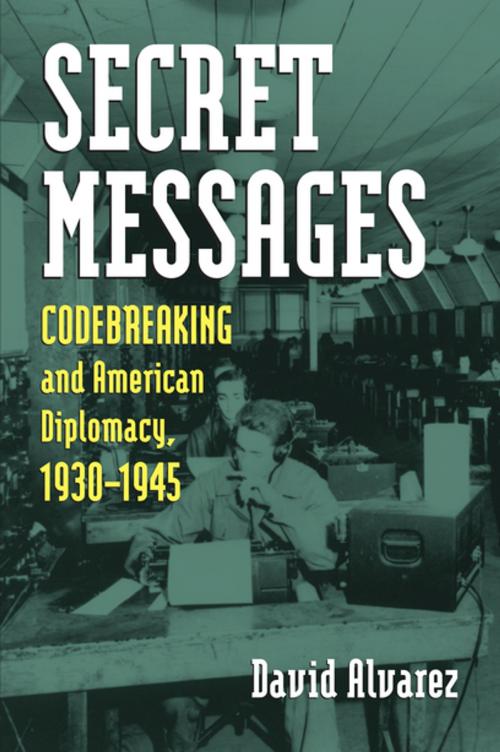Secret Messages
Codebreaking and American Diplomacy, 1930-1945
Nonfiction, History, Military, World War II| Author: | David Alvarez | ISBN: | 9780700622900 |
| Publisher: | University Press of Kansas | Publication: | April 6, 2000 |
| Imprint: | University Press of Kansas | Language: | English |
| Author: | David Alvarez |
| ISBN: | 9780700622900 |
| Publisher: | University Press of Kansas |
| Publication: | April 6, 2000 |
| Imprint: | University Press of Kansas |
| Language: | English |
To defeat your enemies you must know them well. In wartime, however, enemy codemakers make that task much more difficult. If you cannot break their codes and read their messages, you may discover too late the enemy's intentions. That's why codebreakers were considered such a crucial weapon during World War II.
In Secret Messages, David Alvarez provides the first comprehensive analysis of the impact of decoded radio messages (signals intelligence) upon American foreign policy and strategy from 1930 to 1945. He presents the most complete account to date of the U.S. Army's top-secret Signal Intelligence Service (SIS): its creation, its struggles, its rapid wartime growth, and its contributions to the war effort.
Alvarez reveals the inner workings of the SIS (precursor of today's NSA) and the codebreaking process and explains how SIS intercepted, deciphered, and analyzed encoded messages. From its headquarters at Arlington Hall outside Washington, D.C., SIS grew from a staff of four novice codebreakers to more than 10,000 people stationed around the globe, secretly monitoring the communications of not only the Axis powers but dozens of other governments as well and producing a flood of intelligence.
Some of the SIS programs were so clandestine that even the White House—unaware of the agency's existence until 1937—was kept uninformed of them, such as the 1943 creation of a super-secret program to break Soviet codes and ciphers. In addition, Alvarez brings to light such previously classified operations as the interception of Vatican communications and a comprehensive program to decrypt the communications of our wartime allies. He also dispels many of the myths about the SIS's influence on American foreign policy, showing that the impact of special intelligence in the diplomatic sphere was limited by the indifference of the White House, constraints within the program itself, and rivalries with other agencies (like the FBI).
Drawing upon military and intelligence archives, interviews with retired and active cryptanalysts, and over a million pages of cryptologic documents declassified in 1996, Alvarez illuminates this dark corner of intelligence history and expands our understanding of its role in and contributions to the American effort in World War II.
To defeat your enemies you must know them well. In wartime, however, enemy codemakers make that task much more difficult. If you cannot break their codes and read their messages, you may discover too late the enemy's intentions. That's why codebreakers were considered such a crucial weapon during World War II.
In Secret Messages, David Alvarez provides the first comprehensive analysis of the impact of decoded radio messages (signals intelligence) upon American foreign policy and strategy from 1930 to 1945. He presents the most complete account to date of the U.S. Army's top-secret Signal Intelligence Service (SIS): its creation, its struggles, its rapid wartime growth, and its contributions to the war effort.
Alvarez reveals the inner workings of the SIS (precursor of today's NSA) and the codebreaking process and explains how SIS intercepted, deciphered, and analyzed encoded messages. From its headquarters at Arlington Hall outside Washington, D.C., SIS grew from a staff of four novice codebreakers to more than 10,000 people stationed around the globe, secretly monitoring the communications of not only the Axis powers but dozens of other governments as well and producing a flood of intelligence.
Some of the SIS programs were so clandestine that even the White House—unaware of the agency's existence until 1937—was kept uninformed of them, such as the 1943 creation of a super-secret program to break Soviet codes and ciphers. In addition, Alvarez brings to light such previously classified operations as the interception of Vatican communications and a comprehensive program to decrypt the communications of our wartime allies. He also dispels many of the myths about the SIS's influence on American foreign policy, showing that the impact of special intelligence in the diplomatic sphere was limited by the indifference of the White House, constraints within the program itself, and rivalries with other agencies (like the FBI).
Drawing upon military and intelligence archives, interviews with retired and active cryptanalysts, and over a million pages of cryptologic documents declassified in 1996, Alvarez illuminates this dark corner of intelligence history and expands our understanding of its role in and contributions to the American effort in World War II.















